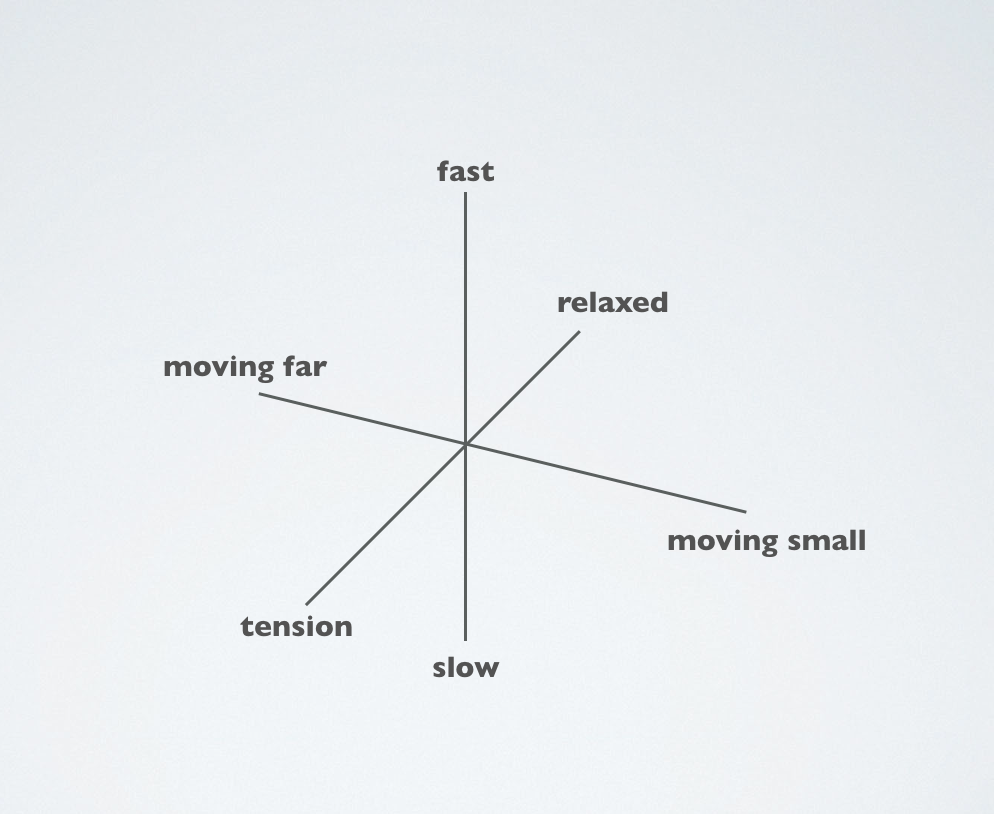Practice Programs
Below is a list of various practice programs that can be used to activate EightOS principles in a group setting. The focus is made on the direct embodied experience of the notion of confluence, which, in turn, leads the group to explore adaptivity and resilience both as the individuals and as a group through the interactive exercises.
Option 1: Basic Activation
Level: Beginner
Number of people: 2 — 100
Duration: 80 minutes
1. Walking and Breathing Exercise
Inhaling through the nose, into the stomach, exhaling through the mouth. Counting the number of steps. Inhaling on 2 steps, exhaling on 2 steps. Walking like this for a while. Then increasing to 3 steps inhale, 3 steps exhale. Up to 8 steps, then going downwards. Reaching back to the comfortable steady rhythm of breathing (2 or 3 in, 2 or 3 out).
Duration: 6 minutes
Objectives: Group synchronization, Elasticity of breathing, Relaxation
2. Variability Walking Exercise
We continue walking and breathing but now our counter shifts into the internal mode. 2 or 3 counts for inhaling, 2 or 3 counts for exhaling. However, now we can run or walk or stop. So our movement’s speed or velocity can change, but our breathing always stays in the same steady rhythm. The intention is to introduce variability in movement while having a base layer rhythm, which provides stability.
Duration: 4 minutes
Objective: Stability, Awareness
3. Copy and Paste / Syncing In Exercise
Continue walking and breathing, but now we can copy and paste the movements of the people from the group or from the outside. Trying to especially work on the idea of confluence, as if we’re connecting to their frequency and physicality for a moment of time, switching into it, staying with it, moving on. People can introduce warmup movements or copy the warmup movements of the other. Trying to play with variability: speed, velocity, position in space — always changing across these parameters.
Duration: 5 minutes
Objective: Confluence, Adaptivity, Synchronization, Feeling connected with the flow

4. Integrity Exercise
One person is the follower. They close their eyes. The leader directs the follower by giving them an impulse into their head (a straight, prolonged, soft vector intention into a certain direction for a few seconds, then changing direction using another hand). The task of the follower is not to change their body structure (e.g. not bend their head) and not to resist at the same time. So they follow, but without creating any tension and keeping their integrity intact. Advanced variation: introduce other body parts. Change roles, change partners
Duration: 6 minutes x 2 pairs = 12 minutes
Objectives: Integrity, Adaptivity
5. Resilience Exercise
We split into groups. One person is pushing, the other one is receiving the push. The one who is pushing is doing it slowly but with a directed intention to go through the body (not only to touch the surface). Trying out the different positions on the body. The one who is receiving the push tries to embrace the incoming impulse, temporarily reconfiguring their structure, and then coming back to the original shape, without creating any tension within. They can move back if they have to, but always come back to the original place, like an elastic that was pulled back (it will only return faster and stronger). Change roles. Change partners (at least once)
Duration: 6 minutes x 2 pairs = 12 minutes
Objectives: Resilience, Elasticity, Modularity, Intentionality, Adaptivity
6. Redirection Exercise
Same as above but now the person who is getting pushed is allowing their body to respond. Movement as a reaction. The body should respond automatically, as if it were moved into another body by the push. So it’s a direct transfer of the energy that was received back into the origin.
Duration: 6 minutes
Objective: Response, Resilience, Assimilation, Redirection
7. Adaptivity Exercise
Split into pairs. One person is leading the other one is following. The one who is leading is just walking in straight lines in the space only changing direction when they reach the extremities. The one who is following has a point of contact with the body of the leader (e.g. hand on the body or arm to arm). Occasionally (e.g. on direction shift) they can change the point of contact. Then change roles. The follower can close their eyes. They task is on the sudden change of direction they should not lose their center and try to keep their structure and integrity intact. Advanced variation: try other body parts.
Duration: 6 minutes x 2 pairs = 12 minutes
Objective: Integrity, Adaptivity, Resilience
8. Implicit / Explicit Control Exercise
In this exercise we combine the exercises 4 and 7. The leader can be just walking and maintaining a point of contact with the follower (ex. 7) or sometimes give an active impulse to the follower (as in ex. 4). Alternating between implicit / explicit control. Shift roles. Second iteration, same pair: now decide when the roles shift through movement, implicitly. Play around with taking control and giving control.
Duration: 6 minutes x 2 pairs = 12 minutes
Objective: Control dynamics, Confluence, Sync
9. Confluent Disruption
Combine 8 and 5 with 6. So can be leader / follower (implicit role shift) but sometimes also integrating the push and response.
Duration: 6 minutes
Objective: Control, Sync, Redirection, Adaptivity, Resilience
10. Liquid Swarm
Combine all the exercises from before but now you can change groups and form constellations not more than 3 people or staying alone. The participants implicitly decide who’s leading and who’s following. Shifting the roles is allowed, but try to add variability into it. Long breaks followed by short ones.
Duration: 6 minutes
Objective: Adaptivity, Swarm, Group dynamics, Resilience, Confluence
Option 2: Advanced Activation
Level: Beginner
Number of people: 2 — 100
Duration: 120 minutes
In this version we add a fluid warmup at the beginning (6 minutes), a recovery breath exercise after walking and before pushing (3 minutes). and a group adaptivity / redirection exercise (after exercise 6) — another 10 minutes per each 10 people.
We also add another exercise:
Fluid Adaptivity:
One person walks, the other one is always changing the body part that is connected. Change roles. Explicit / implicit control transfer.
Option 3: Non-Contact Activation
We exclude all the contact exercises and focus a bit more on the fluid adaptivity exercises, which becomes integrated into the walking and breathing / copy + paste exercise. With a focus on the environment and activating multiple senses (sound / vision / sensory mode)



